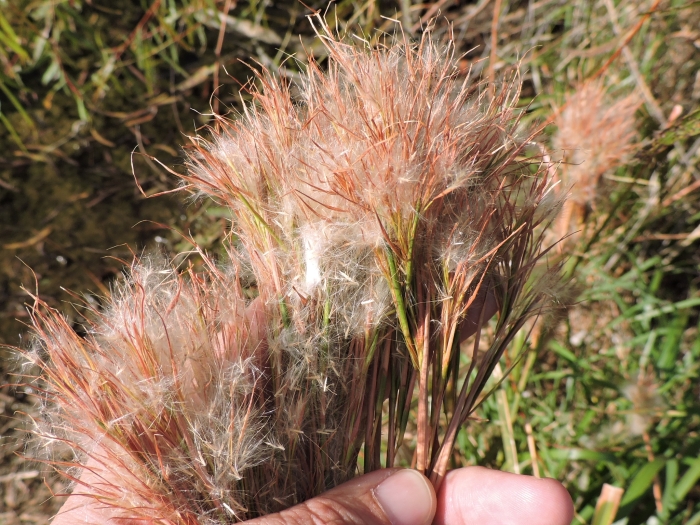Bushy Bluestem
(Andropogon glomeratus)
Bushy Bluestem (Andropogon glomeratus)
/
/

© Sam Kieschnick
CC BY 4.0
Image By:
© Sam Kieschnick
Recorded By:
Copyright:
CC BY 4.0
Copyright Notice:
Photo by: © Sam Kieschnick | License Type: CC BY 4.0 | License URL: http://creativecommons.org/licenses/by/4.0/ | Uploader: sambiology | Publisher: iNaturalist |


















































Estimated Native Range
Summary
Andropogon glomeratus, commonly known as Bushy Bluestem, is a deciduous perennial grass that thrives in wetlands, marshes, and along stream banks in the Southern and Southwestern USA, the Caribbean, and Central America. It is well-adapted to moist, fertile soils and is often found in natural floodplains and wet prairies. This species can reach heights of up to two meters (6 feet) and is notable for its large, fluffy cream-colored inflorescences that appear in late summer to fall. Each dense, tufted inflorescence is composed of several pairs of hairy spikelets. The foliage of Bushy Bluestem is equally attractive, with leaves that may exceed a meter in length, displaying a blue-green hue in the summer and transitioning to a coppery-red color in the fall, providing seasonal interest.
Bushy Bluestem is valued for its ornamental grassy texture and the seasonal color it brings to landscapes. It is often used in naturalistic plantings, rain gardens, and as a component of wetland restoration projects due to its tolerance for wet conditions. It is also beneficial for erosion control along waterways. In cultivation, it requires full sun to maintain its best form and coloration, and it is adaptable to a range of soil drainage conditions, from moist to wet. It is hardy in USDA zones 5–9. While generally low-maintenance, it can self-seed and spread, which should be considered in garden planning.CC BY-SA 4.0
Bushy Bluestem is valued for its ornamental grassy texture and the seasonal color it brings to landscapes. It is often used in naturalistic plantings, rain gardens, and as a component of wetland restoration projects due to its tolerance for wet conditions. It is also beneficial for erosion control along waterways. In cultivation, it requires full sun to maintain its best form and coloration, and it is adaptable to a range of soil drainage conditions, from moist to wet. It is hardy in USDA zones 5–9. While generally low-maintenance, it can self-seed and spread, which should be considered in garden planning.CC BY-SA 4.0
Plant Description
- Plant Type: Grass
- Height: 5-6 feet
- Width: 2-3 feet
- Growth Rate: Moderate
- Flower Color: N/A
- Flowering Season: Summer, Fall
- Leaf Retention: Deciduous
Growth Requirements
- Sun: Full Sun
- Water: Medium, High
- Drainage: Fast, Medium, Slow
Common Uses
Bird Garden, Butterfly Garden, Deer Resistant, Drought Tolerant, Erosion Control, Low Maintenance, Salt Tolerant, Water Garden
Natural Habitat
wetlands, marshes, natural floodplains, wet prairies, and along stream banks
Other Names
Common Names: Brushy Bluestem , Bushy Beard Grass , Bush Beard Grass , Broomsedge
Scientific Names: Andropogon glomeratus , Andropogon macrourus , Andropogon macrourum var. corymbosus , Cinna glomerata , Sorghum glomeratum , Anatherum macrourum , Andropogon densus , Andropogon macrourum var. abbreviatus , Andropogon macrourum var. genuinus , Andropogon macrourus var. genuinus
GBIF Accepted Name: Andropogon glomeratus (Walter) Britton, Sterns & Poggenb.